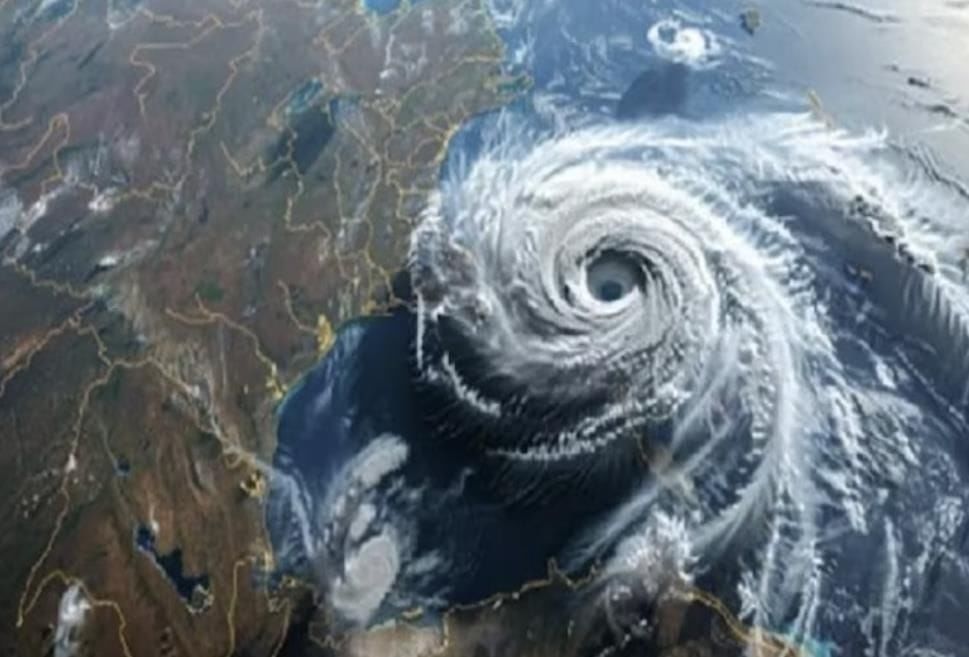Pressure, Winds, Storms, and Cyclones Chapter Notes | Chapter Notes For Class 8 PDF Download
Introduction
Why can a gentle breeze one day become a raging storm the next?
- Every time wind slams a door, swirls leaves, or bends trees, it’s showing us the invisible force of air pressure at work. But what causes pressure, and how do moving air and pressure changes lead to powerful winds, storms, and cyclones?
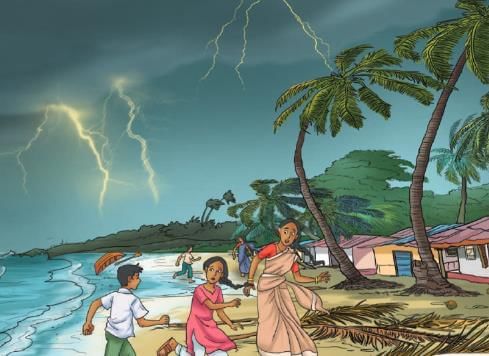
- In this chapter, you’ll discover how pressure and air movements shape the weather—from gentle winds to destructive cyclones—and why these forces matter in our daily lives.
What is Pressure?
- Pressure is defined as the force applied per unit area.
- The formula for pressure is:

- Only the force acting perpendicular to the surface (normal force) is considered for calculating pressure.
Everyday Examples of Pressure
Example 1: When Megha and Pawan go for a picnic, both carry bags of equal weight. Pawan is uncomfortable because his bag has narrow straps while Megha’s has broad straps.
Narrower straps = same force acts on a smaller area ⇒ higher pressure, which hurts more.
Broader straps spread the force over a larger area ⇒ lower pressure, which feels more comfortable.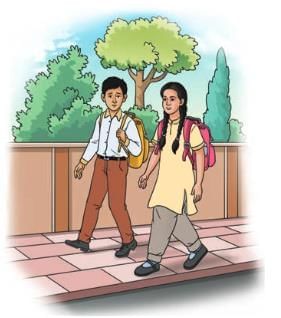
Example 2: When lifting a heavy water bucket, a broad handle is easier on your hand than a narrow one for the same reason.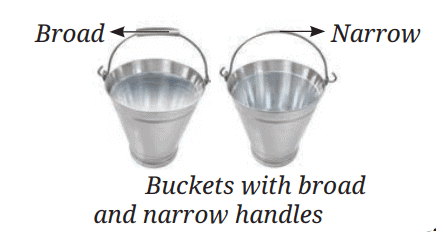
Example 3: When people carry loads on their heads, they often place a round piece of cloth under the load. This increases the area, reducing pressure and making it more comfortable. Porter carrying load
Porter carrying load
Example 4: Using the pointed end of a nail is easier because the small area of the point increases pressure, allowing the nail to pierce the wood with less effort. When you hammer a nail into a wall to hang a picture, the sharp tip cuts through easily due to high pressure.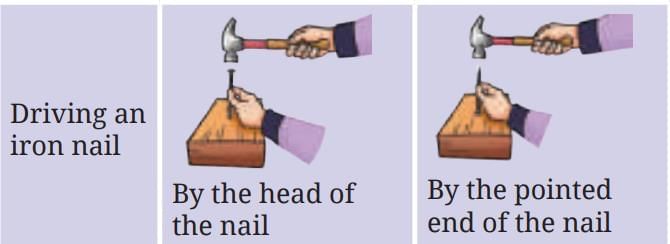
Example 5: Using the sharp edge of a knife cuts the apple easily because the thin edge has a smaller area, creating higher pressure to slice through. Chopping vegetables like carrots or potatoes with a sharp knife is easier than using a blunt one, as the sharp edge applies more pressure.
Example 6: Overhead water tanks are placed high to increase water pressure in pipes, as the height (gravity) adds force to push water through taps. In your house, water flows faster from a tap connected to a rooftop tank compared to a ground-level tank because the height increases pressure.
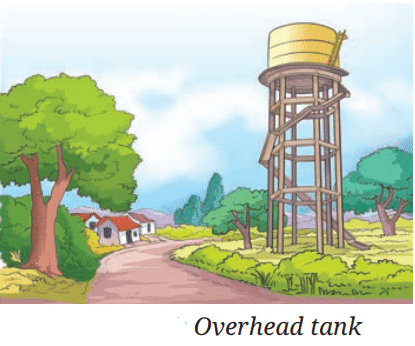
Units of Pressure
- SI unit of force = newton (N)
- SI unit of area = metre² (m²)
- Therefore, SI unit of pressure = newton/metre² (N/m²)
This is also known as a pascal (Pa).
Example 1: Caclulate pressure exerted If 100 N force is applied on 2 m² area:
Ans: If a force of 100 N is applied on a cardboard of area 2m2 , then the pressure applied on the cardboard will be:

Example 2: An elephant stands on four feet. If the area covered by one foot is 0.25 m², calculate the pressure exerted by the elephant on the ground if its weight is 20000 N.
Ans:
Total area for four feet: 4 × 0.25 m² = 1 m².
Pressure = Force / Area = 20000 N / 1 m² = 20000 Pa.
Pressure Exerted by Liquids: Water Column Activity
When two pipes of different diameters each have a balloon tied at the bottom and are filled equally with water, both balloons bulge the same amount—even though the amount (weight) of water is different in each.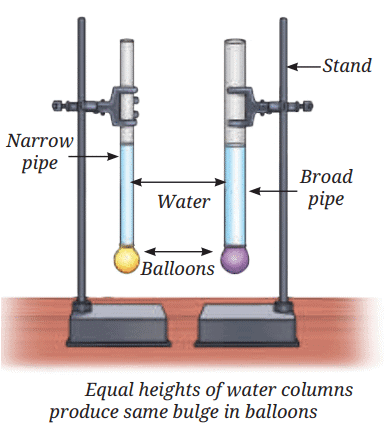
Concept Learned:
- The important thing isn’t the weight or diameter, but the height of the water column.
- Liquid pressure at any point depends only on how high the liquid stands above that point.
- If you pour in even more water, making the column taller, the balloon bulges more—meaning more pressure at the bottom.
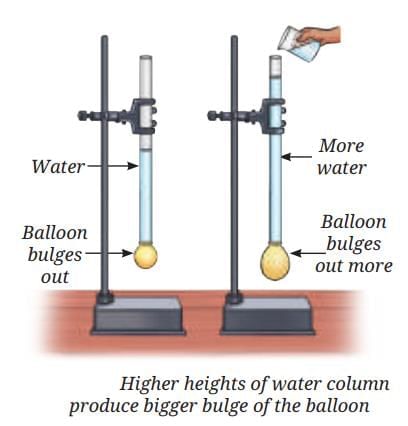
- That’s why overhead tanks are placed high up: the greater the height, the more pressure water has as it flows out the tap.
Pressure Exerted by Liquids: On Walls of Container
If you make small holes near the bottom of a plastic bottle and fill the bottle with water, water squirts out of all the holes sideways.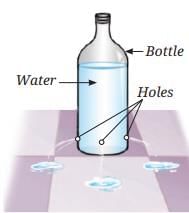
Liquid exerts pressure on walls of container
Concept Learned:
- This shows that liquids exert pressure not just at the bottom but also on the sides of containers.
- The pressure acts in all directions (downwards, sideways).
- Examples in life: Water spurts from holes or cracks in pipes, and the design of dams (broadest at the base) helps them withstand the very strong sideways (horizontal) water pressure at depth.
Why Are Dams Broad at the Base?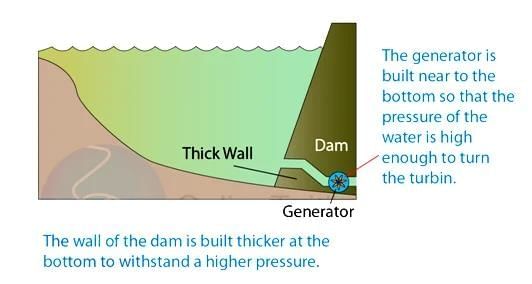
- Water at the bottom of a dam is under higher pressure due to the height of the water column.
- Dam bases are built broad and strong to withstand the large horizontal water pressure near the bottom.
- The deeper the water, the more pressure pushes sideways on the dam walls.
Pressure Exerted by Air
What Is Atmospheric Pressure?
- The envelope of air that surrounds Earth is called the atmosphere.
- The atmosphere contains various gases (mainly nitrogen, oxygen, argon, carbon dioxide) and extends several kilometres above the Earth.
- Atmospheric pressure is the pressure exerted by air molecules on all objects, in all directions.
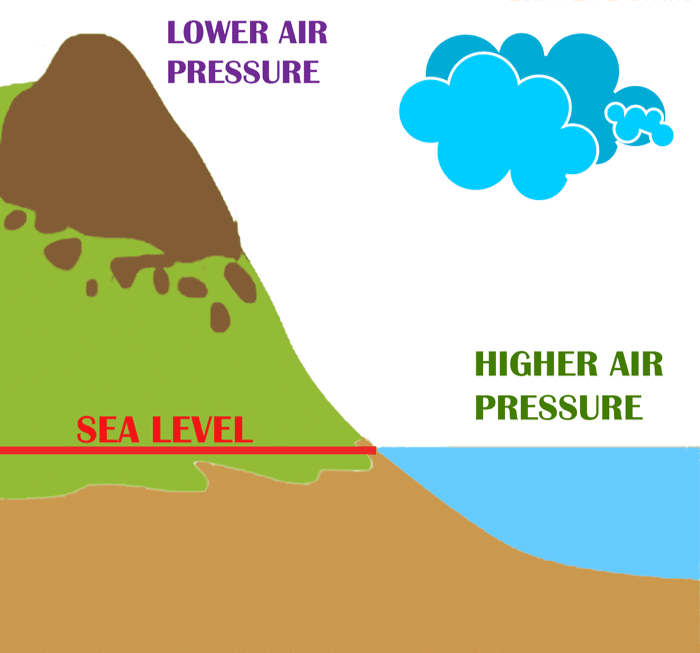 Atmospheric Pressure
Atmospheric Pressure
Does Air Exert Pressure?
When you cover an inverted paper plate (attached to a stick) first with a folded chart paper (small area) and then with an unfolded chart paper (large area) and try lifting the plate by the stick: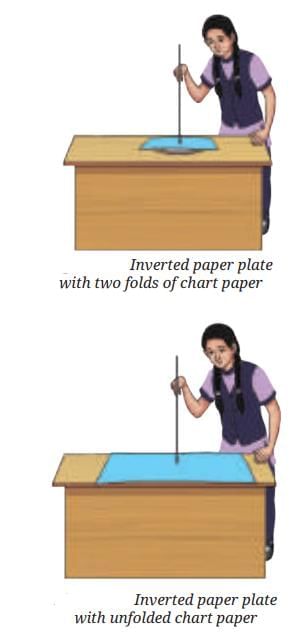
- It’s much harder to lift the plate when the larger sheet is used.
- Main Reason: The larger the surface area covered, the greater the force needed to lift the plate.
- Key Scientific Explanation: Air applies a force (pushes down) on the chart paper; the force increases as the area increases, showing that air all around us is constantly exerting pressure.
Air Pressure in Action: Balloons
- When you blow air into a balloon, it inflates because the air inside pushes outwards in all directions.
- This happens because air exerts pressure in every direction, not just one.
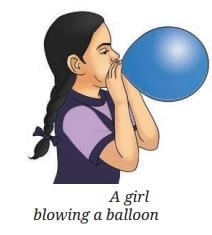
- If you open the mouth of an inflated balloon, the air inside escapes quickly—this is because the air inside is at a higher pressure than the outside, and escapes until the pressure equalizes.
Air Pressure in Action: Using a Rubber Sucker
When you firmly press a rubber sucker onto a smooth surface and remove most of the air underneath: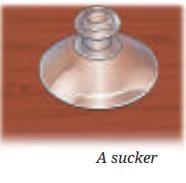
- The outside air pressure is much higher than the pressure inside the cup, causing the sucker to stick.
- When you try to pull the sucker off, you have to overcome the pressure difference.
- This proves that atmospheric pressure is powerful—it presses objects with enough force to hold them tightly unless balanced by another pressure.
How Strong Is Atmospheric Pressure?
- The force exerted by the air column on an area of 15 cm × 15 cm is about 2,250 N—the same as the weight of a 225 kg object!
- Why aren’t we crushed? The reason we are not crushed under this weight is that the pressure inside our bodies is also equal to the atmospheric pressure.
- This balances the pressure exerted from outside. The pressure inside our body is caused by the movement of fluids and gases in tissues and organs of the body.
Units of Air Pressure
The SI unit of pressure is newton per square metre (N/m²), also called a pascal (Pa).
In weather reports and practical measurements, air pressure is often given in:
- Millibar (mb): 1 mb = 100 Pa
- Hectopascal (hPa): 1 hPa = 100 Pa
(So, 1 mb = 1 hPa; both are commonly used and mean the same thing.) - Example: A typical atmospheric pressure at sea level is about 1,013 mb or 1,013 hPa.
- Pascal (Pa) is the SI unit, but millibar (mb) and hectopascal (hPa) are often used when talking about air pressure.
Formation of Wind
Wind blows strongly some days and is calm on others. Sometimes, strong winds can even cause damage. The movement of air (wind) is linked to differences in air pressure. Air moves from a region of higher pressure to a region of lower pressure.
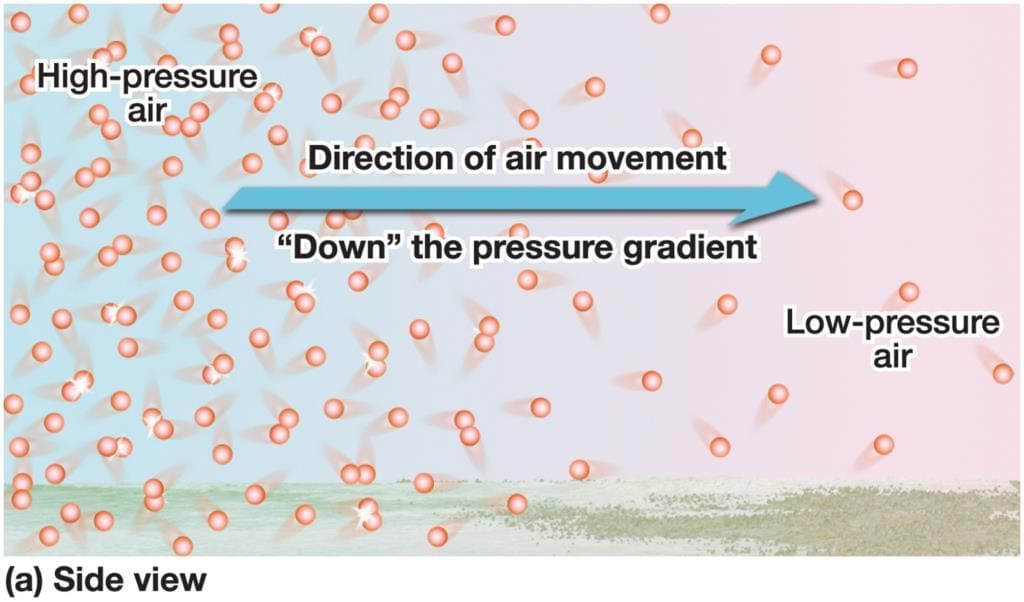 Movement of Air
Movement of Air
Everyday examples:
- If you release the mouth of an inflated balloon, air rushes out until the balloon pressure equals outside pressure.
- When a cycle tube is punctured, air escapes from inside (high pressure) to outside (lower pressure).
Key Concept:
- Air always flows from high pressure to low pressure.
- The flow stops when pressures are equal.
How Pressure Differences Create Winds
Sea Breeze (Daytime):
- Land heats up faster than water.
- Warm air above the land rises (creating low pressure).
- Cooler, high-pressure air from the sea moves in to replace it—this moving air is the sea breeze.
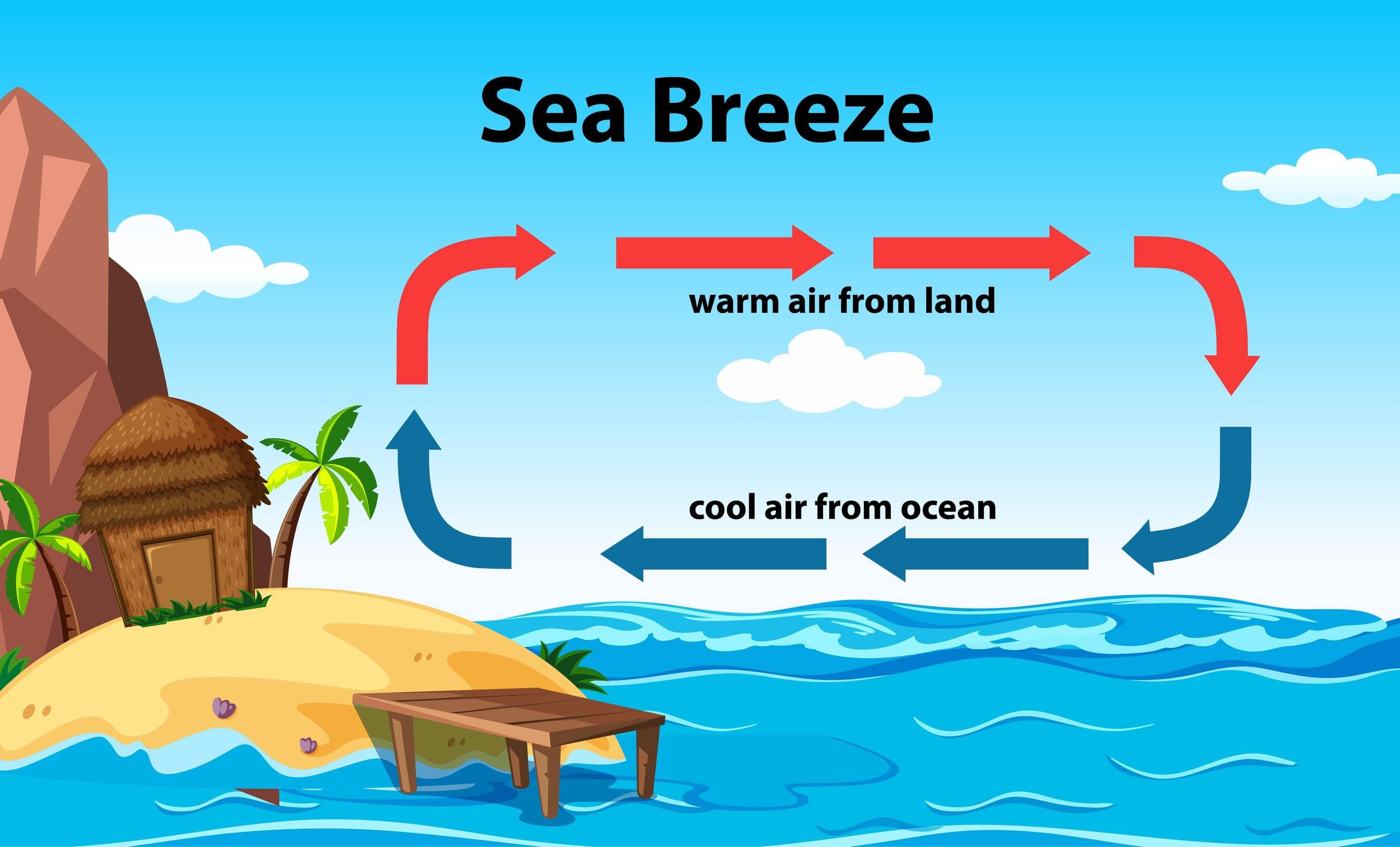 Sea Breeze
Sea Breeze
Land Breeze (Nighttime):
- Water is warmer than land at night.
- Warm air above the sea rises (creating low pressure over the sea).
- Cooler, higher-pressure air from the land moves toward the sea—this is the land breeze.
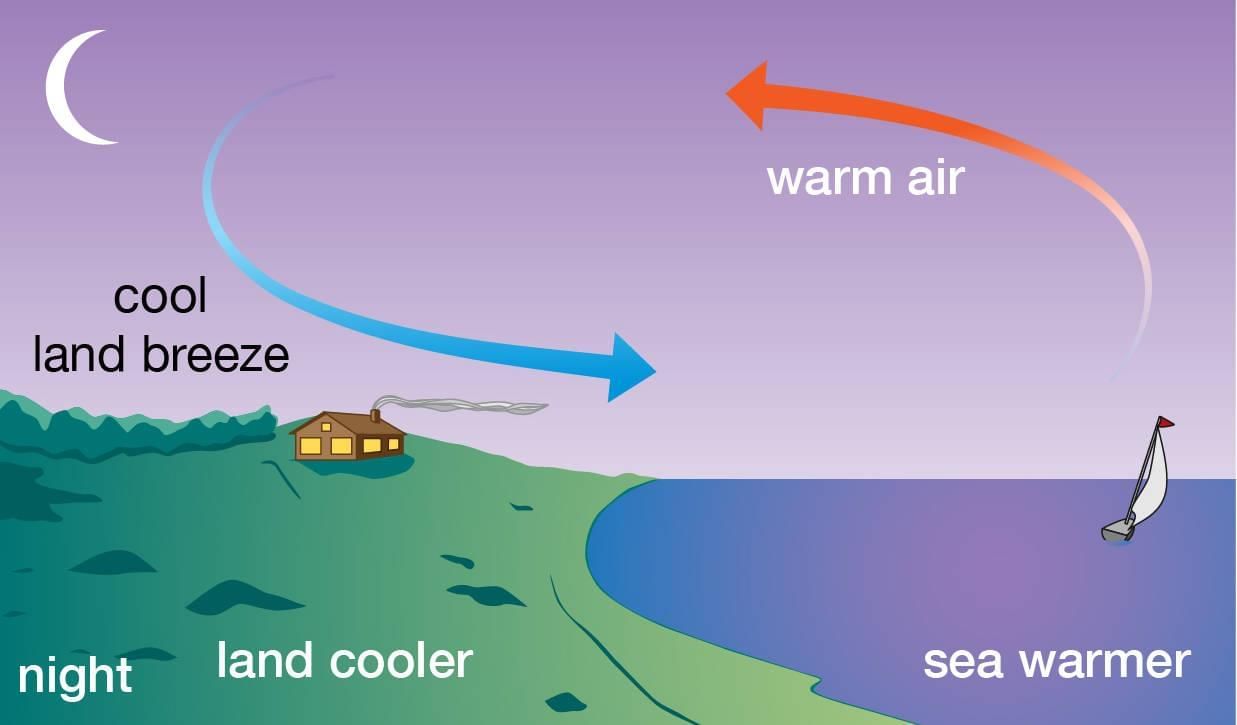 Land Breeze
Land Breeze
Conclusion:
- Winds are created because of pressure differences in the atmosphere.
- The greater the difference in pressure, the stronger the wind speed.
High-Speed Winds Result in Lowering of Air Pressure
High-speed winds create areas of low air pressure. Surrounding higher-pressure air then pushes toward these low-pressure zones.
- Hang two inflated balloons on strings, leaving some space between them.
- Blow air directly between the balloons:
The balloons move toward each other—not away! Blowing harder (faster air) makes them move even closer, more quickly.
Blowing harder (faster air) makes them move even closer, more quickly. - Blowing between the balloons creates a zone of fast-moving air (high wind speed).
- This fast-moving air makes the air pressure between the balloons drop.
- The higher outside air pressure on the opposite sides pushes the balloons together.
- The faster you blow, the lower the air pressure between the balloons and the stronger the effect.
- High-speed wind reduces air pressure in the area where it flows rapidly.
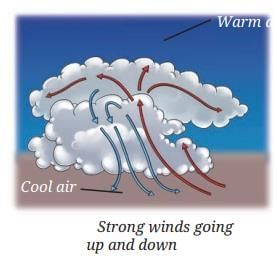 Real-Life Application: Wind and Roofs
Real-Life Application: Wind and Roofs
- During a storm, when strong winds blow over the roof of a house, a zone of low pressure forms above the roof.
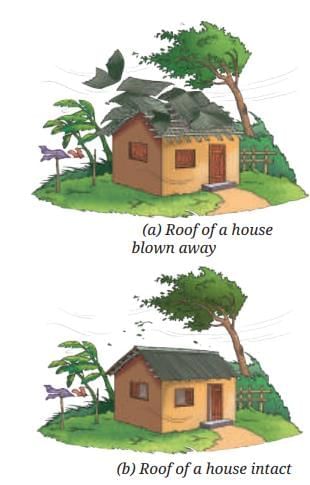
- The air inside the house still has higher pressure.
- The greater pressure from inside can push the roof upwards (sometimes blowing it off) if the difference is strong enough and the roof is weak.
- Safety Tip: Keeping doors and windows open during storms allows air to flow freely, helping equalize the pressure inside and outside, which can prevent roofs from being blown away.
Storms, Thunderstorms, and Lightning
Formation of Storms
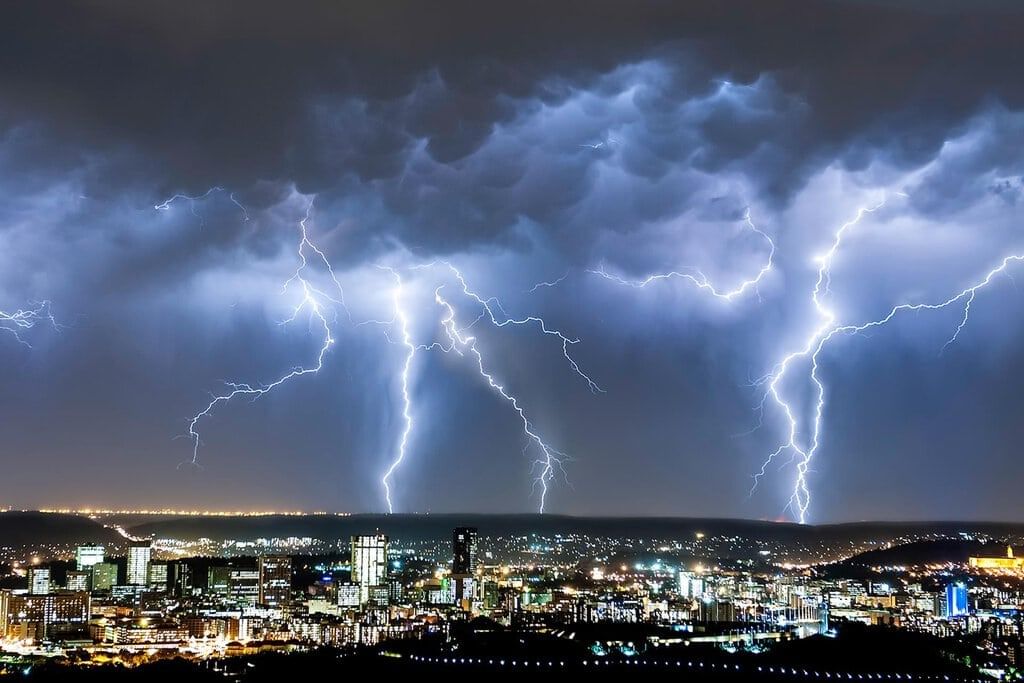 Storm
Storm
- Land heating: Sun heats the land, causing the air above it to get warm and moist.
- Air rises: Warm, moist air being lighter rises, creating a low-pressure area.
- Air circulation: Cooler air from high-pressure areas moves in to replace it; this air gets heated and rises too.
- Cloud formation: Rising air cools and moisture condenses to form water droplets.
- Rain: Water droplets join, get heavier, and fall as rain, hail, or snow.
- Strong winds + rain = Storm: Strong moving air, often with heavy rain, is called a storm.
- Storms are frequent in: Hot, humid, tropical regions (like India).
How Thunderstorms and Lightning Happen
Updrafts and Downdrafts:
In some storms, air rises to such great heights that the low temperature turns water droplets into ice particles.
Strong winds push water droplets and ice particles up and down inside the clouds.
Charging of Clouds:
As water droplets and ice particles rub against each other, they get electrically charged (just like when you rub two objects together).
Lighter, positively charged ice particles move to the top of the cloud.
Heavier, negatively charged water droplets gather at the bottom.
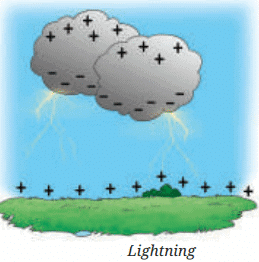
Separation of Charge:
The cloud ends up with opposite charges at top and bottom.
When the negatively charged bottom of the cloud comes close to the ground, it induces a positive charge on the ground and nearby objects like trees and buildings.
Lightning Formation:
Normally, air acts as an insulator and prevents charges from meeting.
If charge buildup is very high, air’s resistance breaks down, causing a sudden flow of charges—this is seen as a bright flash of light called lightning.
Lightning can happen:
Within a cloud
Between clouds
Between clouds and the ground
Thunder: Lightning heats the air rapidly, causing it to expand and produce a loud sound called thunder.
Thunderstorm: A storm that has thunder and lightning is called a thunderstorm.
Regional Names and Importance of thunderstorms:
Local thunderstorms in India have different names:
- Kalboishakhi: West Bengal, Bihar, Jharkhand
- Bordoisila: Assam
- Mango showers: Kerala, Karnataka, Tamil Nadu
- They often help in crop growth or fruit ripening (like mangoes and coffee).
Protect yourself during lightning:
Lightning is dangerous—it can start fires, damage buildings, and injure or kill people and animals.
- Stay away from tall objects (trees, poles).
- Find a low, open area and crouch; do NOT lie flat on the ground.
- Don't use umbrellas with a metallic rod.
- If in water, get out immediately.
- If inside a car or bus, stay inside—you are comparatively safer.
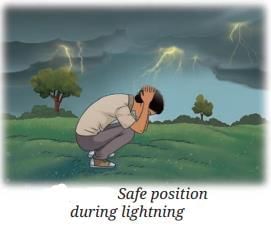
Lightning Conductor: How Buildings Are Protected
- Lightning conductor: A pointed, metallic rod installed along the wall of a building.
- The pointed end is higher than the roof.
- The lower end is buried deep in the ground.
- Purpose: Provides a safe path for electric charges from lightning to flow directly into the ground, preventing damage to the building.
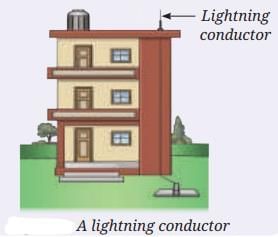
Cyclone
A cyclone is a large, spinning storm system that forms over warm ocean waters. It involves high-speed winds, heavy precipitation, and very low pressure at its center.
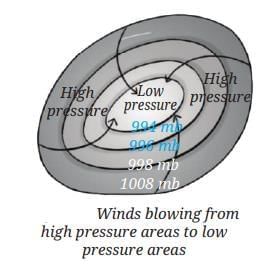
How Do Cyclones Form?
Heating and Rising Air:
Warm ocean water heats the air above it, making the air moist and light.
This warm, moist air rises up, leaving a low-pressure area below.
Condensation and Further Warming:
As the air rises, water vapour in it condenses to form raindrops.
Condensation releases heat, which warms the air even more, causing it to rise further and pressure to drop more.
Intensification and Spinning:
More surrounding air rushes in to fill the low-pressure area and also rises.
The rotation of the Earth causes the moving air to spin.
This cycle continues, making the low-pressure center even stronger.
Cyclonic Structure:
The result is a rapidly-spinning system of clouds, winds, and rain—this is a cyclone.
At the center is the eye of the cyclone—a calm zone of lowest pressure.
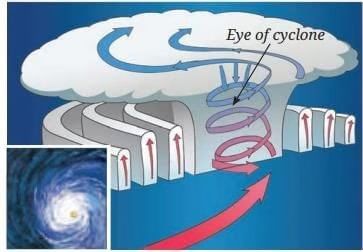
Around the eye are high-speed winds and heavy rain.
On Landfall:
When the cyclone reaches land, it loses its source of warm, moist air and weakens.
Even after weakening, cyclones can leave behind massive destruction.
Why Are Cyclones Dangerous?
Cyclones can uproot trees, blow off roofs, break power lines, and destroy buildings.
- Storm Surge: Strong winds push ocean water toward land, creating a high wall of water (3–12 meters tall). This surge can flood coastal and even distant inland areas.
- Heavy Rainfall: Causes rivers to overflow, leading to floods and landslides.
- Seawater Damage: Saltwater can contaminate drinking water. Seawater can flood and make fields less fertile, damaging crops.
- Blocked Roads & Power Outages: Fallen trees and debris can block help from reaching affected areas. Long-lasting power outages disrupt emergency response and daily life.
Staying Safe During a Cyclone
- Stay informed: Regularly listen to radio/TV for weather warnings (India Meteorological Department, IMD).
- Be prepared: Keep an emergency kit ready (Food, water, medicines, flashlight, batteries).
- Shelter: Move quickly to a nearby cyclone shelter or safe building if advised.
- Weather monitoring: Satellites now help track and predict cyclones, reducing loss to life and property.
- Authorities: Many organizations work together to respond to cyclone disasters nationally and internationally.
Let's Wrap up!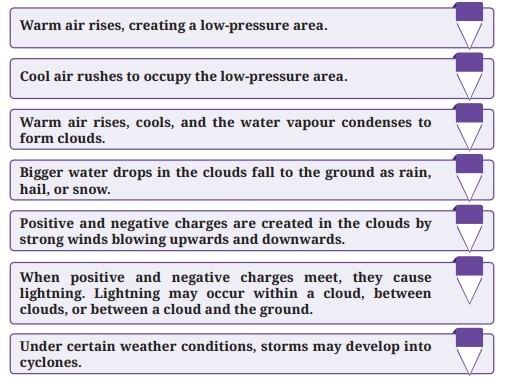
Key Terms to Remember
- Pressure: Pressure is defined as the force exerted per unit area.
- SI Unit of Pressure: The SI unit of pressure is the newton per square metre (N/m²), also called the pascal (Pa).
- Pressure by Liquids and Gases: Liquids and gases exert pressure on the walls of their container.
- Atmospheric Pressure: The pressure exerted by the air around us is known as atmospheric pressure.
- Cause of Winds: Differences in air pressure cause winds to blow.
- Low and High Pressure: Warm air rises to create a low-pressure area; cooler air from high-pressure areas moves in to replace it.
- Formation of Thunderstorms: Moisture and strong winds are important for the formation of thunderstorms.
- Development of Electric Charges: Upward and downward strong winds rub ice particles with water droplets in clouds, creating electric charges.
- Lightning Formation: Lightning is caused by the collision of electric charges within a cloud, between different clouds, or between a cloud and the ground.
- Effects of Lightning: Lightning strikes can cause destruction to life and property.
- Lightning Conductors: Lightning conductors are devices that protect buildings from the damaging effects of lightning.
- IMD (India Meteorological Department): The IMD constantly monitors cyclones and thunderstorms in India.
FAQs on Pressure, Winds, Storms, and Cyclones Chapter Notes - Chapter Notes For Class 8
| 1. What is pressure and how is it defined in scientific terms? |  |
| 2. How does air pressure influence the formation of wind? |  |
| 3. Why do high-speed winds result in lower air pressure? |  |
| 4. What are the characteristics and causes of thunderstorms and lightning? |  |
| 5. Why are cyclones considered dangerous, and what impacts do they have? |  |


